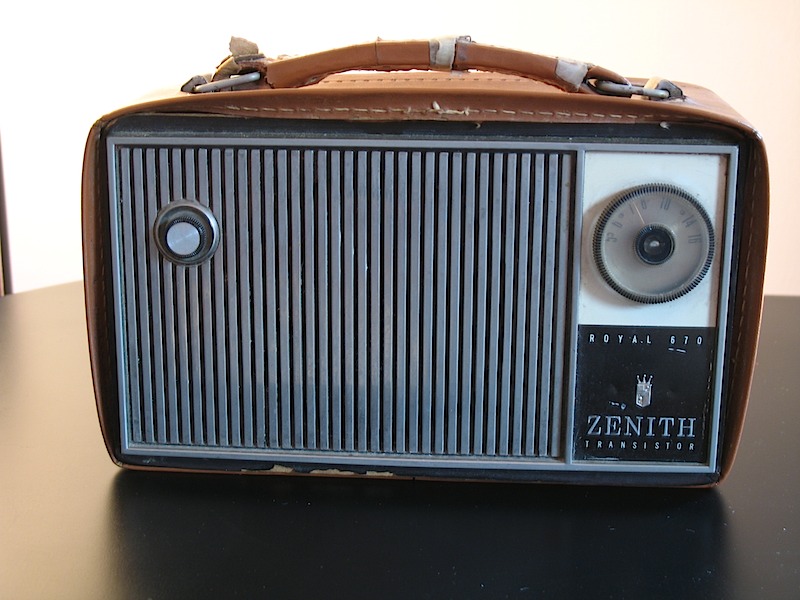
This Zenith Royal 670 is the radio that's been in my family the longest.
I remember when my dad bought this radio from an appliance store in Boonville, Missouri, in 1963. He worked for the University of Missouri Extension Service and often had to drive around the state in state-provided cars. To save money, the state ordered its fleet of cars without radios. So he carried this radio around, often putting it in the dashboard. In full view of the sun. Amazingly, the radio still works well, the speaker cone is intact, and the case is in fair condition.
The case is made out of a material that Zenith called "Perma-Wear." Unfortunately, it's more wear than perma. Most notably, the rear snaps that hold the case in place don't really work any more. And you do have to open the back to get to the batteries. The radio plays seemingly forever on its 4 "C" cells.
The headphone jack is also in the back. It takes a standard 3.5mm phone plug. It surprised me to see a 3.5mm jack on an American-made radio dating from the early 1960s, but there it is.
A 1963 Zenith brochure shows this radio as the Royal 670L. The description in the brochure indicated that the radio would run for 300 hours on a set of batteries. The dial is small, but has a nice, smooth, geared tuning action. It's AM-only. Zenith made a few portable AM/FM radios in the early 1960s. Back then, though, most radio listening was done on AM.
The "L" in the model description might have represented "long life" or "long distance". According to Norman Smith's Zenith Transistor Radios, Evolution of a Classic, the 670L is the successor to the Royal 675LG. The Royal 675LG was itself a 1962 redesign of the Royal 675, originally added to the Zenith line-up in 1959. Smith quotes the Royal 670L's retail price at $39.95.
It wasn't a top-of-the-line radio, such as the ones that Jay Allen describes in his article on "lunchbox" radios, such as the Zenith Royal 755 line. Zenith called them luggage style radios.)
Transistor counts were a big marketing tool in the 1960s, too. The Royal 670 has one fewer transistor than a radio in the Royal 700 line would have and had a lower maximum audio output. Even so, Norman Smith described the performance of the Royal 675LG and, by extension, the performance of the Royal 670L, as "exceptional". My own experience has been similar. It is a sensitive radio. It can be outperformed by others, but it's definitely better than average.
While I'm not generally in the market for AM-only radios, it does make me wonder how a Royal 755 in good condition would do.
The dial very much reflects its time, with the CD markings at 640 and 1240 kHz. Those were the two "CONELRAD" frequencies. In the event of an emergency, most local radio stations were supposed to go off the air. One station in a given area would be allowed to broadcast at 640 or 1240 -- even if their usual frequency was different. Some stations had transmitters that could switch to their assigned CONELRAD frequency. A station that I worked at had one of these transmitters still at the station when I first worked there in 1979. It was kept as a backup. The station transmitted at 1400, but for CONELRAD emergencies, there was a switch in the front to broadcast at 1240 instead. I don't know how well it worked; CONELRAD didn't make it past the 1960s. Its legacy lives on in the Emergency Notification System tests that radio and TV stations are still required to conduct once a week. "This is a test" and so on.
The radio sounds best with the built-in speaker. Through headphones, a high-end roll-off is quite apparent. Zenith was capable of making AM radios with better high-frequency performance, but those were usually table radios. For portables, I believe it was thought that frequency response could be traded off for selectivity, to be able to hear distant stations better. I estimate that the Royal 670's frequency response rolls off at 4 kHz. That's about what many present-day portables do. It's adequate for talk and news but not so listenable for music.
This radio wasn't my first radio (that one doesn't work any more though I still have it). But it's the longest-lasting one in my collection. It's a tribute to the quality and craftsmanship of Zenith's 1960s products.